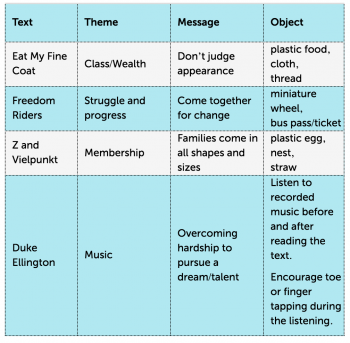What?
Realia are real-life objects that enable children to make connections to their own lives as they try to make sense of new concepts and ideas. This strategy brings the Perspectives central text to life for students by using everyday objects during the read aloud.
When?
During and after reading
Why?
Objects provide a concrete manipulative for students to handle while listening to the read aloud. The neuron stimulation from physical movement during the read aloud also helps students to conceptualize the ideas and themes present in the text. Realia also create total physical responses that help students recall ideas and themes from the text in later discussions.
How?
- Select a Perspectives central text to read aloud.
- Determine what themes, messages, information and facts are being communicated through the text.
- Brainstorm possible objects that can be distributed among students and used as a manipulative during the read aloud. Note that the concept of realia can include music.
- Distribute the objects to each student prior to the read aloud.
- Share authentic replicas (instead of relying on still photos only) for objects that may be unfamiliar to children (e.g., for a unit on transportation, bring in replicas of unfamiliar modes such as gondolas or hot air balloons).
- When sharing historical accounts in text, try to complement these with exploration of real objects at a museum (e.g., cars, televisions, telephones and washing machines from previous eras). Encourage children to think about dimensionality, function and what they learned from the real object that they would not have learned from the picture.
- Direct students to connect the object to their understanding of the central text while they listen.
- After the read aloud, discuss student connections using the following questions:
- How is the object related to the text?
- How does the object represent the characters in the text?
- How does the object relate to the speaker of the text?
- How can the object help you remember the message or theme of the text?
- What, if any, other objects could represent the text’s message or theme?
English language learners
This strategy elicits Total Physical Response (TPR), which lets English language learners engage the text by moving, touching, pointing and role-playing.
Connection to anti-bias education
Realia encourages participation. Students hear the text and directly associate their comprehension to the object placed before them; manipulating the object during the read aloud solidifies their understanding of the text’s message. Extending the after-reading questions to include what other objects might serve as realia for the same text encourages students to pull in their individual perspectives and experiences.

